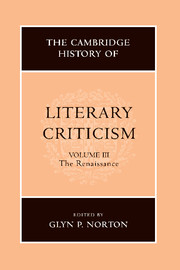Book contents
- Frontmatter
- Introduction
- READING AND INTERPRETATION: AN EMERGING DISCOURSE OF POETICS
- POETICS
- I Humanist classifications
- II The rediscovery and transmission of materials
- III Rhetorical poetics
- IV Literary forms
- 20 Italian epic theory
- 21 The lyric
- 22 Renaissance theatre and the theory of tragedy
- 23 Elizabethan theatrical genres and literary theory
- 24 Defining comedy in the seventeenth century: moral sense and theatrical sensibility
- 25 Dialogue and discussion in the Renaissance
- 26 The essay as criticism
- 27 The genres of epigram and emblem
- 28 Humour and satire in the Renaissance
- THEORIES OF PROSE FICTION
- CONTEXTS OF CRITICISM: METROPOLITAN CULTURE AND SOCIO-LITERARY ENVIRONMENTS
- VOICES OF DISSENT
- STRUCTURES OF THOUGHT
- NEOCLASSICAL ISSUES: BEAUTY, JUDGEMENT, PERSUASION, POLEMICS
- A SURVEY OF NATIONAL DEVELOPMENTS
- Bibliography
- Index
- References
25 - Dialogue and discussion in the Renaissance
from IV - Literary forms
Published online by Cambridge University Press: 28 March 2008
- Frontmatter
- Introduction
- READING AND INTERPRETATION: AN EMERGING DISCOURSE OF POETICS
- POETICS
- I Humanist classifications
- II The rediscovery and transmission of materials
- III Rhetorical poetics
- IV Literary forms
- 20 Italian epic theory
- 21 The lyric
- 22 Renaissance theatre and the theory of tragedy
- 23 Elizabethan theatrical genres and literary theory
- 24 Defining comedy in the seventeenth century: moral sense and theatrical sensibility
- 25 Dialogue and discussion in the Renaissance
- 26 The essay as criticism
- 27 The genres of epigram and emblem
- 28 Humour and satire in the Renaissance
- THEORIES OF PROSE FICTION
- CONTEXTS OF CRITICISM: METROPOLITAN CULTURE AND SOCIO-LITERARY ENVIRONMENTS
- VOICES OF DISSENT
- STRUCTURES OF THOUGHT
- NEOCLASSICAL ISSUES: BEAUTY, JUDGEMENT, PERSUASION, POLEMICS
- A SURVEY OF NATIONAL DEVELOPMENTS
- Bibliography
- Index
- References
Summary
The present survey traces the theory and practice of dialogue from the fifteenth to the seventeenth century, the two centuries when the form most flourished in Western European letters. During this period, the theorists of dialogue, who were often also its practitioners, conceived of their enquiry as engaging the broadest issues of language and social behaviour. The study of the genre is at once critical and historical, since writers of dialogue develop their ideas both within an intellectual exchange and within a larger social context. Recent studies have accordingly examined Renaissance dialogue either in its formal aspect (as literary structure and the articulation of argument) or in its referential aspect (as a mirror of society and a record of language).
The humanist dialogue arose in Italy around 1400, contemporary with the revival of Greek studies and with new styles in the visual arts. Generally a learned composition written in Latin, the dialogue of this initial period reflects the new philosophical freedom and eclecticism which were fostered by the rise of mercantile communes and by the weakening of papal authority through schism. Appropriately, the favoured model is the Roman orator Cicero, whose dialogues depict the leisurely philosophizing of learned optimates. While providing arguments on opposite sides of a question [in utramque partem], Cicero leaves his debates unresolved and hence implicitly open for the reader to decide.
Although no Quattrocento writers of dialogue formulate explicit theories of the genre, their choices of theme and structure imply a critical awareness of specific goals in reviving classical forms.
- Type
- Chapter
- Information
- The Cambridge History of Literary Criticism , pp. 265 - 270Publisher: Cambridge University PressPrint publication year: 1999
References
- 2
- Cited by



